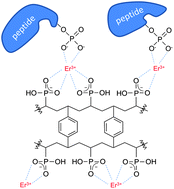A new type of metal chelate affinity chromatography using trivalent lanthanide ions for phosphopeptide enrichment†
Abstract
In this study, a new type of immobilized metal-ion affinity chromatography (

Maintenance work is planned for Wednesday 1st May 2024 from 9:00am to 11:00am (BST).
During this time, the performance of our website may be affected - searches may run slowly and some pages may be temporarily unavailable. If this happens, please try refreshing your web browser or try waiting two to three minutes before trying again.
We apologise for any inconvenience this might cause and thank you for your patience.
* Corresponding authors
a
Institute of Analytical Chemistry and Radiochemistry, Leopold-Franzens University of Innsbruck, Innrain 80-82, 6020 Innsbruck, Austria
E-mail:
m.rainer@uibk.ac.at
Fax: +43 512 507 57399
Tel: +43 512 507 57307
b P.C.M.D., International Center for Chemical and Biological Sciences, University of Karachi, Karachi 75270, Pakistan
c Theoretical Chemistry Division, Institute of General, Inorganic and Theoretical Chemistry, Leopold-Franzens University of Innsbruck, Innrain 80-82, 6020 Innsbruck, Austria
d Biocenter, Division of Cell Biology, Innsbruck Medical University, Innrain 80-82, 6020 Innsbruck, Austria
In this study, a new type of immobilized metal-ion affinity chromatography (

 Please wait while we load your content...
Something went wrong. Try again?
Please wait while we load your content...
Something went wrong. Try again?
M. R. Mirza, M. Rainer, C. B. Messner, Y. Güzel, D. Schemeth, T. Stasyk, M. I. Choudhary, L. A. Huber, B. M. Rode and G. K. Bonn, Analyst, 2013, 138, 2995 DOI: 10.1039/C3AN36853J
To request permission to reproduce material from this article, please go to the Copyright Clearance Center request page.
If you are an author contributing to an RSC publication, you do not need to request permission provided correct acknowledgement is given.
If you are the author of this article, you do not need to request permission to reproduce figures and diagrams provided correct acknowledgement is given. If you want to reproduce the whole article in a third-party publication (excluding your thesis/dissertation for which permission is not required) please go to the Copyright Clearance Center request page.
Read more about how to correctly acknowledge RSC content.
 Fetching data from CrossRef.
Fetching data from CrossRef.
This may take some time to load.
Loading related content
